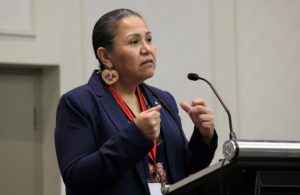Sacred Indigenous Knowledge scholar educates Anishinabek front-line workers on cannabis

By Laura Barrios
TORONTO— The Anishinabek Nation Health Department hosted the Key Health and Social Factors for a Cannabis Strategy Forum in Toronto earlier this month, where Anishinabek front-line workers had a direct platform to voice experiences, ideas, and recommendations that will be incorporated into an Anishinabek Nation Cannabis Health Strategy.
Participants were asked what cannabis meant to them as a way to understand where the mindset was at the beginning of the two-day forum. While some participants viewed cannabis from a point of concern, responding with “harmful, misuse, and concern,” most participants responded with views such as “medicine, economic opportunities, pain-management.”
Participants received a comprehensive presentation from Carol Hopkins, a Sacred Indigenous Knowledge scholar (PhD equivalent in western-based education) and the Executive Director of the Thunderbird Partnership Foundation, a foundation that she describes as, “the national voice advocating for First Nations culturally-based addictions services.”
“Our knowledge has to be the foundation. It’s not an afterthought or if it’s convenient – we have to start the conversation from, ‘How does culture play a role? How can it work?’ If you think about cannabis from all of those perspectives, who does it draw attention from? How is social services responding? What about the justice system in the community? Outside of the community?”
Hopkins, who is a First Nation representative at the United Nations Commission on Narcotic Drugs, believes that when it comes to cannabis, those at the forefront of developing laws or frameworks need to think about it from every population across the lifespan in terms of how cannabis may affect them.
“How do the unborn factor in how communities address cannabis?” she asked. “My role is to represent these frameworks and say, ‘Where are the Indigenous people in these frameworks?’”
“When you’re thinking about strategies and what to do, what do you need to do to from a health and social services lens? How do you secure belonging – people, environment, land, family— and having a sense that there’s a way forward? The rational and the intuitive – manmade law, spirit law—putting those two together is the only way we have a full understanding on the meaning of life. How does this apply to the cannabis environment?”
Hopkins notes that there is limited information available on the prevalence, severity, source of supply, and social impacts of drug use amongst First Nations in Canada, which would be helpful to develop a strategy.
“Thunderbird Partnership Foundation has developed a community-based data collection and analytical tool that can be applied by Indigenous communities across the country.”
Through the First Nations Opioid Survey, findings show that 30 per cent of First Nations whose population reported misusing opioids in a harmful way, do not have access to treatment, whether culturally-based or not. In order to manage withdrawals, they use cannabis when they do not have access to treatment. Results from the Survey, which aims to understand the use of other substances in First Nations, concluded that 34 per cent of surveyed adults use cannabis to reduce the use of other drugs (opioids), while 64 per cent of adults use cannabis for pain relief.
“In our community, one of the things that we recognize is the use of drugs, especially when we look at the misuse of opioids, it stems from trauma. It’s less a criminal activity as it is a social problem,” stated Nipissing First Nation Chief Scott McLeod. “We’ve developed a program where we bring all of the services together. The team is brought together to assess an individual to see what types of support and services those individuals need.”
Further to what Chief McLeod shared, Hopkins added that in order to look at the impacts that cannabis can have on a human brain, whether good or bad, awareness of trauma impacts on brain development is also something to be considered.
“Trauma significantly impacts the development of the frontal cortex,” she explained. “We don’t have the outcry to address that trauma. There have been studies of people who have died by suicide—a post-mortem study— they look at brains of people who die of suicide and those that didn’t. In fact, there was the emotional part of our brain that sits just under the prefrontal cortex, and at the back, we all have a hippocampus; it’s responsible for emotional memory. Every human being has it. People who died by suicide had damage showing to their brain to the hippocampus. So, when people do not have an outlet for their trauma, it shows up in our brain function and it can lead to suicide. When we’re concerned [about cannabis impact on the brain], we have to be aware of trauma impacts on the brain’s development.”
Proven by the varying opinions of the participants at the start of the forum, and wide-ranging information provided by Hopkins, an argument can be made that cannabis has negative impacts on the human brain and well-being, just as much as it being medicinal and healing.
“There are opposing views on banning cannabis and education,” Hopkins said. “The goal of conversation is not to fight what way is right or wrong but to understand why people take the position that they take. Whether you leave the conversation with a different mindset, it gives people an opportunity to talk about their position.”
Participants discussed the current challenges that the legalization of cannabis has created for their community and identified gaps in services and resources to support the overall health and well-being of their citizens. Understanding the current cannabis landscape within the Anishinabek Nation First Nations is vital to the development of the Anishinabek Nation Cannabis Health Strategy.

